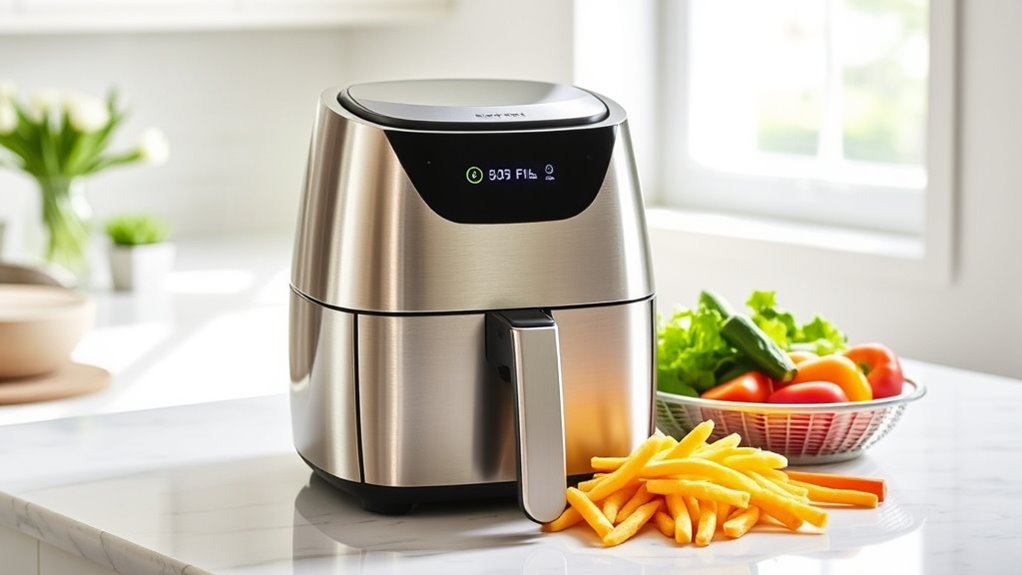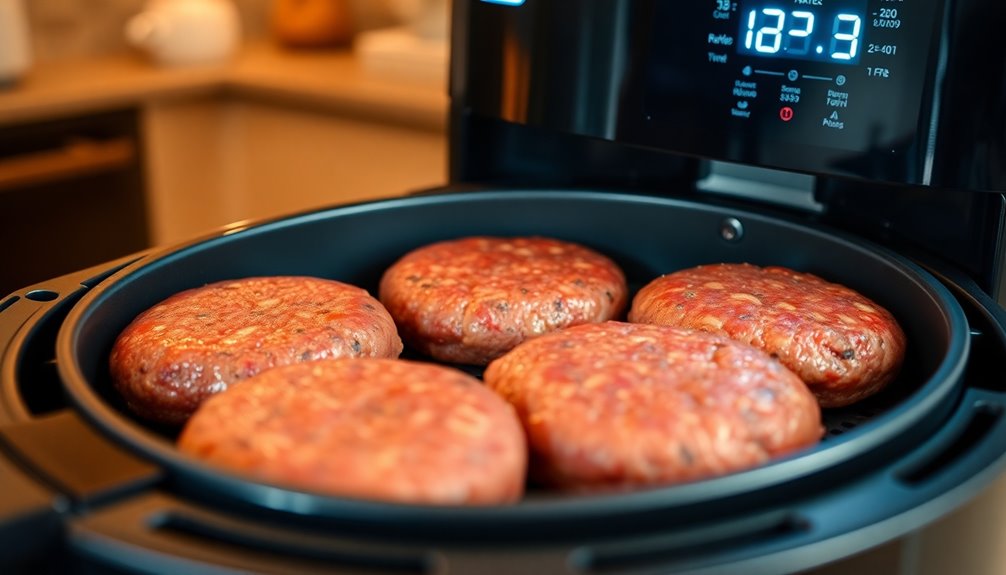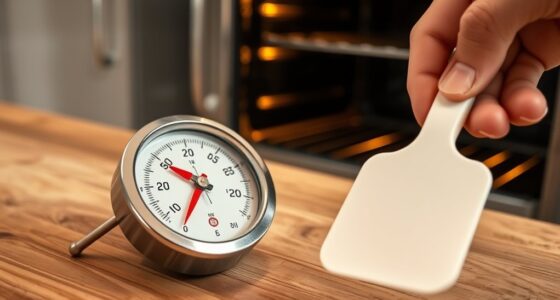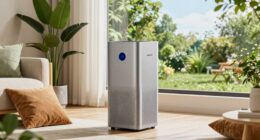To get started with your new air fryer, unbox it carefully, wash the basket and accessories, and run it empty at 400°F for 10 minutes to eliminate odors. Place it on a flat surface near an outlet in a well-ventilated area, and follow safety tips like handling hot parts with gloves. Start with simple recipes and adjust cooking times for perfect crispy results. Keep exploring the tips to guarantee long-lasting, healthy, delicious meals.
Key Takeaways
- Unbox and thoroughly clean the basket and accessories before first use to remove manufacturing residues.
- Place the air fryer on a stable, ventilated surface away from walls and follow the initial 10-minute 400°F run.
- Familiarize yourself with the control panel, preset functions, and recommended temperature/time settings for beginner recipes.
- Ensure proper ventilation during operation and avoid overcrowding the basket for even cooking and safety.
- Regularly clean and maintain the appliance, including the basket, tray, and exterior, to ensure longevity and optimal performance.
Unboxing and Setting Up Your Air Fryer
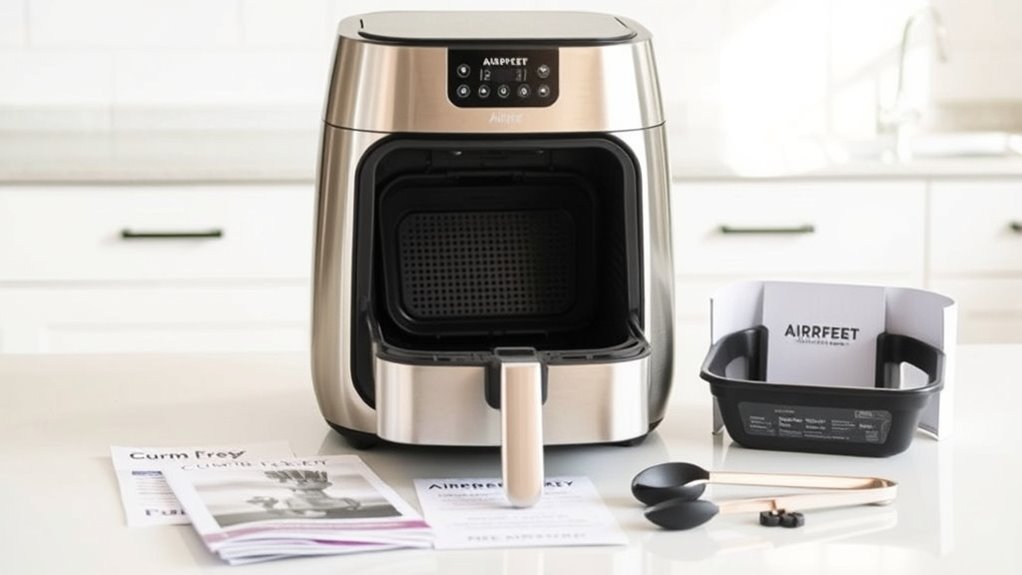
Unboxing your new air fryer is the first step toward enjoying healthier, crispy meals. Carefully open the box and remove all packaging materials, including styrofoam and plastic wraps. Check that all components are included—usually the main unit, basket, and any accessories. Rinse the basket and accessories with warm water and mild soap, then dry thoroughly. Place the air fryer on a flat, stable surface near an outlet. Before plugging in, read the user manual for safety tips and setup instructions. Verify the area is clear of obstructions and has proper ventilation. Connect the power cord to an outlet, but don’t turn it on yet. Taking these initial steps guarantees a smooth start with your new appliance.
Understanding Your Air Fryer’s Controls and Features

Getting familiar with your air fryer’s controls and features helps you cook with confidence and precision. First, identify the main control panel, which usually includes a digital display, buttons, or dials. The display shows the temperature, cooking time, and preset options. Use the buttons or dials to select your desired temperature, typically between 180°F and 400°F, and set your cooking time. Many models have preset functions for common foods like fries, chicken, or vegetables, making cooking easier. Some air fryers also feature a shake reminder or a keep-warm setting. Take time to read your user manual to understand specific features, such as adjustable racks or dehydrate functions. Mastering these controls lets you tailor your cooking, ensuring perfect results every time. Understanding your appliance’s features and controls enhances your cooking experience and helps you achieve optimal results. Familiarizing yourself with precise temperature control can further improve your cooking outcomes by allowing more accurate adjustments. Additionally, being aware of the tuning capabilities in your air fryer can help optimize performance for different recipes. Exploring these advanced features can also expand your cooking options and efficiency.
Basic Safety Tips for Using Your Air Fryer

To keep your air fryer safe to use, make sure the ventilation is clear to prevent overheating. Always handle hot surfaces carefully to avoid burns, and don’t overcrowd the basket, so your food cooks evenly. Following these simple safety tips helps guarantee a smooth and safe cooking experience. Additionally, familiarize yourself with best practices for appliance safety to ensure you use your air fryer effectively and securely. Properly maintaining your appliance can also prevent family photoshoot fails by reducing stress caused by appliance malfunctions or safety concerns. Incorporating sound healing science principles, such as ensuring proper ventilation, can further enhance your safety by promoting optimal device operation.
Keep Ventilation Clear
Ever wondered why proper ventilation is essential when using your air fryer? It’s because your appliance releases heat, steam, and sometimes smoke during cooking. Without good airflow, these can accumulate, causing heat buildup and potential fire hazards. Make sure your air fryer is placed in a well-ventilated area, away from walls or cabinets that block airflow. Keep the vents clear of dust, grease, or obstructions to guarantee proper functioning. If your kitchen has an extractor fan or range hood, turn it on to help vent steam and odors outside. Regularly inspect the vents to prevent buildup. Proper ventilation not only keeps your air fryer running efficiently but also reduces the risk of overheating or smoke-related issues. Ensuring proper air circulation is a key safety practice to prevent hazards during use, especially since proper Gold IRA management can help diversify your investments and protect against market volatility. Additionally, understanding how prophetic dreams might symbolize subconscious messages can remind users to stay attentive to safety cues during cooking. Proper ventilation practices can also help reduce lingering odors and improve overall kitchen air quality.
Handle Hot Surfaces
Since your air fryer heats up quickly, it’s important to be cautious when handling it during and after cooking. The exterior and basket can become very hot, so always use oven mitts or heat-resistant gloves when touching or removing parts. Avoid grabbing the basket or tray with bare hands, as you risk burns. When opening the lid or door, do so carefully to prevent steam burns from hot air escaping. Place hot parts on heat-proof surfaces and keep children or pets away from the area. After cooking, give the air fryer time to cool down before cleaning or storing it. Regularly inspecting for thermal hazards is essential to prevent accidents and maintain safety. Staying alert to hot surfaces helps prevent accidents and keeps you safe while enjoying your new appliance. Additionally, always refer to the safety guidelines provided by the manufacturer to ensure proper use and maintenance. Being aware of proper handling techniques can further reduce the risk of injury during use. Incorporating advanced safety features, such as automatic shutoff or cool-touch exteriors, can also enhance overall safety during operation.
Avoid Overcrowding Basket
Overcrowding the air fryer basket can lead to uneven cooking and safety hazards. When you pack too much food into the basket, hot air can’t circulate properly, resulting in undercooked spots or soggy textures. This can also cause the appliance to work harder, increasing the risk of overheating or malfunctions. To guarantee your food cooks evenly and safely, leave space between pieces so air can flow freely. Use multiple batches if necessary, rather than overstuffing the basket. Not only will this improve your results, but it also helps prevent accidents caused by overheating or spillage. Always check your air fryer’s maximum fill line and follow the manufacturer’s recommendations for prime performance and safety. Proper airflow ensures consistent cooking and prolongs your appliance’s lifespan. Additionally, maintaining proper air circulation helps avoid potential safety issues related to overheating. Ensuring good heat transfer is essential for efficient and safe operation of your air fryer. Regularly inspecting and cleaning your air fryer can also help maintain optimal performance and safety standards.
First Steps: Preparing Your Air Fryer for Use

Before using your new air fryer for the first time, it’s important to give it a thorough initial clean. This removes any manufacturing residues and guarantees safe, fresh cooking. Here’s what to do:
- Remove all packaging and any protective film or stickers.
- Wash the basket, rack, and pan with warm, soapy water, then dry thoroughly.
- Wipe down the interior and exterior with a damp cloth, avoiding the heating element.
- Place the basket inside, plug in the air fryer, and run it empty at 400°F (200°C) for 10 minutes to eliminate odors.
- To ensure optimal performance, check the air fryer’s safety features and adjust settings accordingly before regular use. Regular maintenance and understanding breast cancer symptoms factors can also help in maintaining your appliance’s longevity and safe operation. Additionally, consulting the initial cleaning procedures recommended by the manufacturer can provide further guidance for safe operation.
Simple Recipes to Try When You First Start

Getting started with your air fryer can be exciting, especially when you try simple recipes that don’t overwhelm your new appliance. Start with easy dishes like crispy fries, chicken tenders, or roasted veggies. These recipes help you get comfortable with timing and temperature. To make it easier, here’s a quick guide:
| Food | Temperature (°F) | Cooking Time |
|---|---|---|
| Frozen French Fries | 400 | 15-20 min |
| Chicken Tenders | 375 | 10-12 min |
| Roasted Broccoli | 375 | 8-10 min |
Experimenting with these basics builds confidence. Keep it simple, and soon you’ll discover your favorites!
Tips for Achieving Perfectly Crispy Results
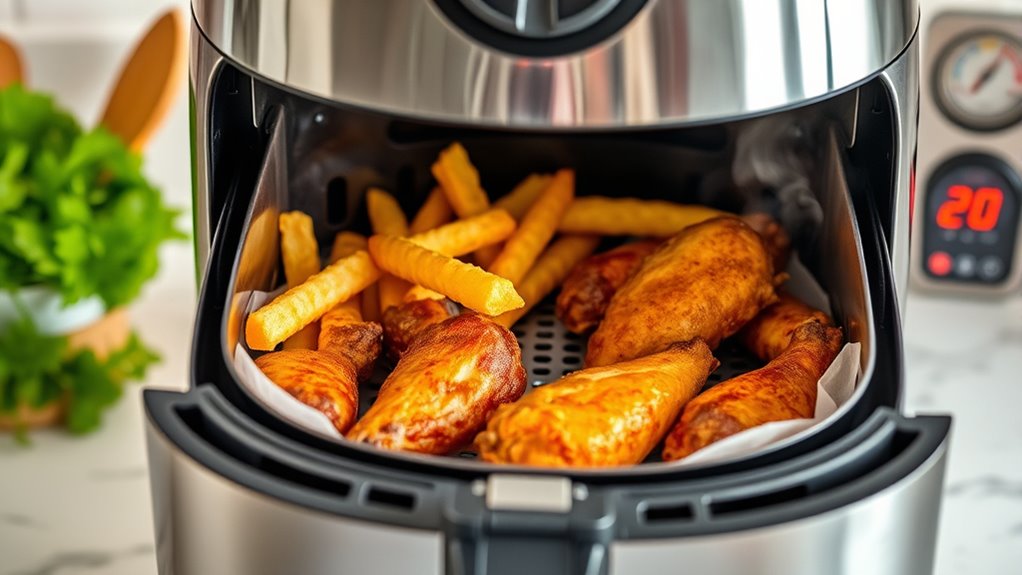
Achieving perfectly crispy results with your air fryer is all about understanding how to optimize airflow and temperature. To get that ideal crunch, follow these tips:
- Don’t overcrowd the basket—give food space to allow hot air to circulate evenly.
- Use a light coating of oil to enhance crispiness without making it greasy.
- Shake or flip food halfway through cooking to promote uniform browning.
- Adjust the temperature and cooking time based on the food’s thickness and type.
Maintaining and Cleaning Your Air Fryer Properly
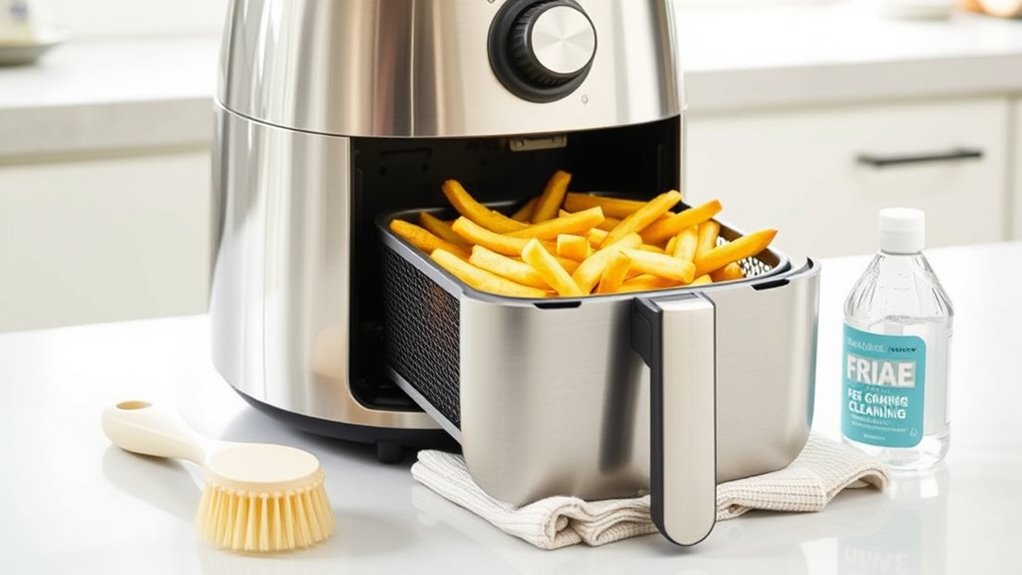
To keep your air fryer working efficiently, you need to follow a regular cleaning routine and maintain its parts properly. Cleaning after each use prevents buildup and ensures your food stays tasty and healthy. Taking good care of your appliance will help it last longer and perform at its best.
Regular Cleaning Routine
Regularly cleaning your air fryer is essential for maintaining its performance and ensuring food tastes great every time. A clean appliance cooks more evenly and lasts longer. To keep your air fryer in top shape, follow these steps:
- Unplug and let it cool down before cleaning.
- Remove and wash the basket and tray with warm, soapy water, then dry thoroughly.
- Wipe down the interior with a damp cloth, avoiding abrasive cleaners.
- Clean the heating element gently with a soft brush if needed to remove any residue.
Proper Part Maintenance
Proper maintenance of your air fryer’s parts is essential for its longevity and peak performance. Regularly inspect the basket, tray, and heating element for buildup or damage. Clean removable parts after each use with warm soapy water, ensuring you remove any food residue or grease. Avoid abrasive cleaners that could scratch surfaces. For stubborn debris, soak parts in warm water before scrubbing gently. Check the seals and hinges periodically, tightening or replacing them if needed, to ensure proper operation. Never immerse the main unit in water—use a damp cloth for cleaning. Proper maintenance prevents malfunctions, extends the lifespan of your appliance, and keeps your food tasting its best. Consistent care ensures your air fryer remains reliable and safe to use.
Frequently Asked Questions
Can I Use Aluminum Foil or Parchment Paper in My Air Fryer?
Yes, you can use aluminum foil or parchment paper in your air fryer, but with caution. Make sure to avoid covering the entire basket, as it can block airflow and affect cooking. Always leave space around the foil or paper so hot air circulates properly. Using these materials makes cleanup easier and prevents sticking, but always follow your air fryer’s guidelines to guarantee safe and effective use.
How Do I Troubleshoot Uneven Cooking or Burning?
If your food cooks unevenly or burns, start by checking the air fryer’s temperature and cooking time. You might be using too high a temperature or overcrowding the basket, which blocks airflow. Shake or turn your food halfway through cooking to promote even browning. Also, make certain the basket is clean and not overfilled. Adjust settings as needed and monitor closely to achieve consistent, delicious results.
Is It Safe to Cook Raw Meat Directly in the Air Fryer?
Did you know that 85% of home cooks trust their air fryer for safe meal prep? Cooking raw meat directly in your air fryer is safe when you follow proper guidelines. Preheat the device, season your meat, and cook to the recommended internal temperature—such as 165°F for chicken. Always use a meat thermometer to guarantee safety and avoid undercooking, making your meals both delicious and secure.
What Accessories Are Recommended for Expanding My Air Fryer’S Capabilities?
To expand your air fryer’s capabilities, you should consider accessories like silicone mats to prevent sticking, metal racks for stacking multiple layers, and baking pans for desserts or casseroles. A skewers set allows for grilling kebabs, while a pizza pan helps make crispy pizzas. These accessories make cooking more versatile, letting you prepare a wider variety of meals with ease and creativity.
How Can I Prevent Food From Sticking or Tearing During Cooking?
Imagine you’re in a time machine, trying to preserve the magic of your food. To prevent sticking or tearing, always preheat your air fryer and lightly spray or brush the basket with oil. Use parchment liners or silicone mats for delicate items. Don’t overcrowd the basket, so air flows freely. Flip or shake food halfway through cooking, ensuring even doneness and easy removal without damage.
Conclusion
Now that you’ve revealed the secrets of your new air fryer, you’re ready to turn it into your kitchen’s best-kept secret. Think of it as your culinary magic wand, transforming simple ingredients into golden, crispy delights with a flick of your wrist. With each cook, you’ll craft delicious moments that sizzle and shine. Embrace the journey, and soon your kitchen will be filled with the irresistible aroma of perfectly crispy creations, making every meal a masterpiece.
